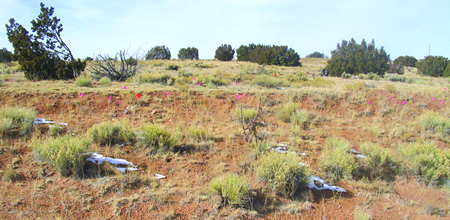
Archaeological Research
 The modern interest in the history
of the Galisteo Basin begins with researches of Adolf Bandelier in the 1880s.
Although using historic records as his starting point, he strove to connect written
glimpses of history to archaeological sites that both had a place in, and
clearly preceded, the Spanish colonization of northern New Mexico. The Galisteo
Basin became an archaeological region with the work of Nels Nelson in 1912,
ushering in both the modern era of archaeology in the nation and laying the
foundation for our modern understandings. Investigations have been sparse in
the subsequent century, focusing on more narrowly defined research goals, with
important contributions by Bertha Dutton and modern initiatives by James Snead.
In addition to buildings, sherds, and flakes, the Galisteo Basin is the setting
for one of the worlds great collections of rock art, supporting distinct
research programs that are ongoing.
The modern interest in the history
of the Galisteo Basin begins with researches of Adolf Bandelier in the 1880s.
Although using historic records as his starting point, he strove to connect written
glimpses of history to archaeological sites that both had a place in, and
clearly preceded, the Spanish colonization of northern New Mexico. The Galisteo
Basin became an archaeological region with the work of Nels Nelson in 1912,
ushering in both the modern era of archaeology in the nation and laying the
foundation for our modern understandings. Investigations have been sparse in
the subsequent century, focusing on more narrowly defined research goals, with
important contributions by Bertha Dutton and modern initiatives by James Snead.
In addition to buildings, sherds, and flakes, the Galisteo Basin is the setting
for one of the worlds great collections of rock art, supporting distinct
research programs that are ongoing.
“Galisteo” sites—a concept which includes sites within adjacent drainages such as the Rio Santa Fe—are a rich resource for many archaeological topics. A partial list includes:
|
• Aggregation of many smaller communities into much larger settlements. What can be learned about the actual population sizes of the communities? • The development, trade, and source of the prolific glaze pottery production by the related sites. Exploitation of other resources such as obsidian was extensive and is amenable to detailed study of sources and exchange. • The interaction and both aggregation of and conflict among the various linguistic traditions of the pueblos and relationships with tribes from the Great Plains to the east. • Agricultural and climatic studies to research means and methods of supporting the large populations indicated by the large pueblos. • Distribution and interpretation of rock art symbols—to what extent can interfacing of different groups be defined? What changes in ideology can be detected? Can activity subsets in some of the extensive panels such as those on the Creston or at San Cristóbal be identified? • What is the relationship of the various sites and clusters of sites to one another? • Further inquiry into relationships of settlements in the basin to modern Native American communities. |
The opportunities for furthering anthropological and cultural knowledge are limitless in the Galisteo Basin. Protecting the resource and judiciously permitting research are obligations and opportunities.

© New Mexico Office of Archaeological Studies, a division of the New Mexico Department of Cultural Affairs.
The Center for New Mexico Archaeology
7 Old Cochiti Road
Santa Fe, NM 87507
505-476-4404
Fax: 505-476-4448

